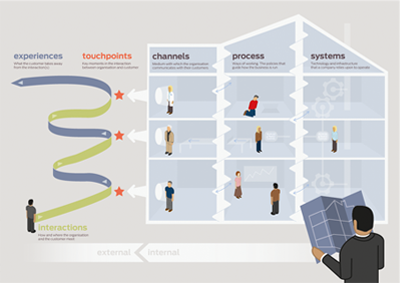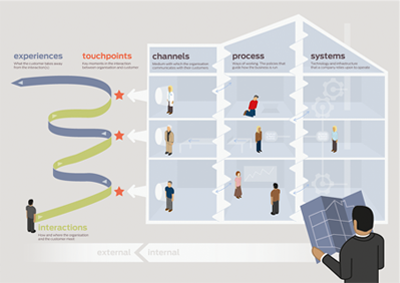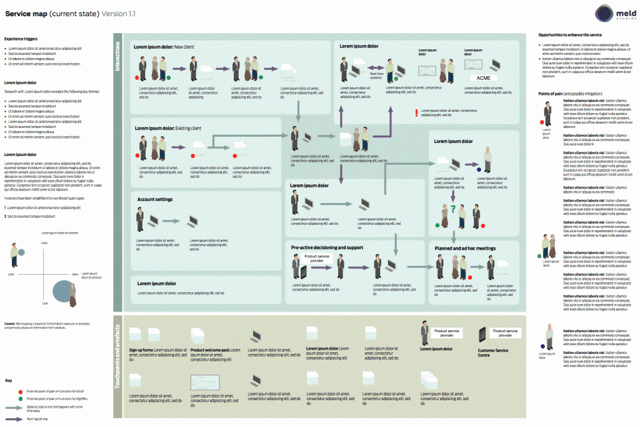A service design approach is required to deliver great customer experiences

Internally focussed business tools, processes and systems are often thought about and designed in isolation from the design of the things customers interact with. Or to put this another way, projects that focus on improving the customer experience often don't fully consider the tools, processes and systems staff use in the delivery of the experience.
Keeping the internal and external worlds separate may appear like the only, or the simplest way to do things, especially for highly fractious, silo-ed organisations, but this approach often results in disjointed services where the investment in designing the customer experience can be completely undermined by the poor resources staff have to deliver the service.

Organisations understand the value of great customer experiences
Organisations increasingly understand and see the value in developing great customer experiences. In commoditised markets, customer experience is often seen as the way of driving organisational value, the way of differentiating one company from another and avoiding the need to compete on price and/or features.
The business justification for spending time and money on the conscious design of customer experiences is nowadays, thankfully, not too difficult to make. Customer experience is increasingly becoming a no-brainer ever since the likes of Apple and Zappos have proven how exceptional customer experiences can drive exceptional business value. And this recognition of the value of customer experience is further borne out by the explosion of customer experience jobs that has gone on within Europe, the US and Australia in the last 5 to 10 years.
The customer experience is only the tip of the iceberg
Although the things a customer directly interacts with are very, very important to design well, they are only a small and often comparatively simple part of delivering a successful service. They are the tip of the iceberg, the most tangible and obvious things, but if a company only spends effort of the design of the things a customer directly interacts with they are likely to deliver a lousy service.
Below the surface lurks the complexity of the staff experience of delivering the service. This is often very messy. Staff are expected to deliver these great customer experiences and yet organisations seldom design great staff experiences to enable them to do so.
Typically staff are expected to deliver great customer experiences from within highly silo-ed environments, using messy processes and archaic systems that don’t talk elegantly to one another.
Basically they are services that only work because humans can work around their deficiencies. With training, experience and a prevailing wind, most of the time they will probably, somehow succeed. But if an organisation understands the value of customer experience, surely that isn’t good enough. You want to be able to guarantee that staff have absolutely the best opportunity of delivering a great customer experience.
Staff experiences are often held together with duct tape
Staff generally end up performing heroics to ensure that customer’s have a good experience. They are constantly dealing with fudged solutions that everyone acknowledges aren’t right, but no one can muster the energy or budget to do much about.
One of the major issues is that investment in solving these problems isn't, or can't be tied back to the delivery of the cherished customer experience.
This is even the case in many highly sophisticated organisations who know and appreciate the value of great customer experience. For example, we were recently working with one such organisation to increase the conversion of prospective customers.
We were given an open remit to design any of the aspects of the service that research proved to be failing or in need of improvement. This gave us the exciting opportunity to design and test new marketing materials, sales tools, conversation scripts, online application processes, direct mail communications, the list goes on and on.
In fact we ended up redesigning nearly every aspect of the service that customers interact with, but whenever we mentioned deficiencies in the staff experience, we were fairly directly told that it wouldn't be possible to redesign those things at this stage. But things became different once we were able to directly tie the staff experience to a negative impact on the customer experience.
Staff and customer experiences meet within the context of service design
When designing a customer experience, many organisations don’t give much or any consideration to the needs of the organisation to deliver the customer experience. Customer experience projects can be shallow in both their scope and execution. They often only deal with the visible part of the iceberg, but there is far more below the surface that they either don’t recognise, or choose not to deal with.
Organisations need to apply a broader lens to problem solving. To realise the full value of their investment in customer experience design, they need to understand, value and design the holistic internal and external experience of the service.
It is certainly simpler to just deal with the customer facing part of the experience, but the organisations that deliver truly great customer experiences understand that they must also design great staff experiences.
What is required is an approach that not only lionises the customer, but also recognises that great experiences don’t just happen, one must understand and design staff experiences, to stand any chance of being able to deliver the desired customer experience.
The design of an exceptional service requires you to follow the journey into the organisation to understand the staff experience of supporting the customer experience. To understand the systems and processes they use in all their glorious technicolour. To understand the efficiencies and inefficiencies, the functions and disfunctions that make up the way the organisation works. And to understand how all this drives value for the organisation. Only from this broader perspective of the service experience and a deeper understanding of the totality of things that affect the customer experience, can one design and deliver consistently exceptional services.
Service mapping is the way to start
Service mapping helps an organisation clearly see the relationship between the external and internal worlds. The effect that the experience they offer their staff has on their valued customers.
The idea of service mapping is very simple. You look to produce a single map that includes the following things:
- The customer experience of a service - this is typically the narrative that sits at the top of the mapping.
- The physical artefacts that the customer interacts with, this means things like websites, call centres, brochures, etc, etc.
- All interactions between the customer and the organisation - what is referred to as the onstage actions.
- The interactions that go on within the organisation to deal with the customer’s request - the backstage actions who talks to who, what processes they use.
- And then you have the backend systems used to record information, or provide information to staff.

What you end up with is something that creates a clear and succinct connection between the external and internal worlds. It clearly connects the highly valued customer experience with the tools, processes and systems that internal staff use to deliver the experience.
We have found this technique highly successful in getting organisations to recognise the need to design the staff experience.
I am sure we'll post more about service mapping in the near future, but in the meantime, if you are keen to find out more, please get in touch - iain@meldstudios.com.au.
